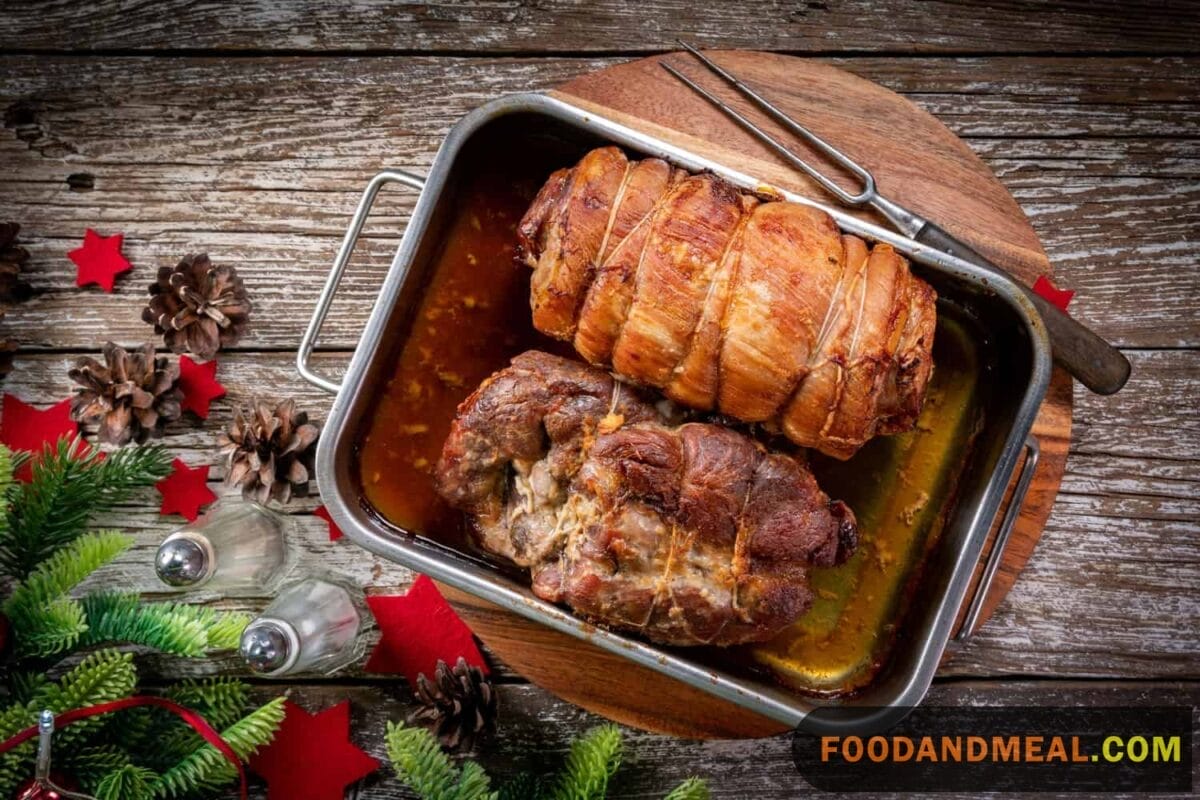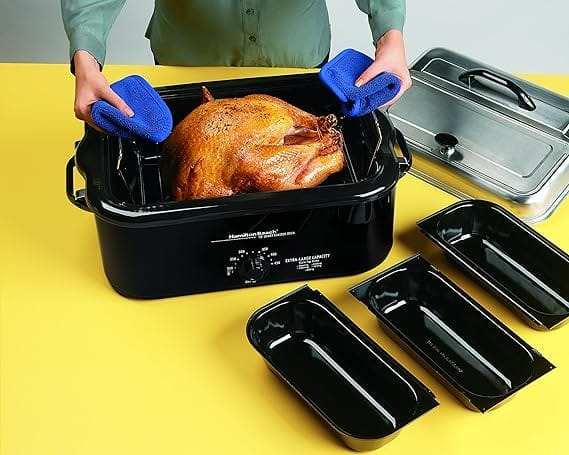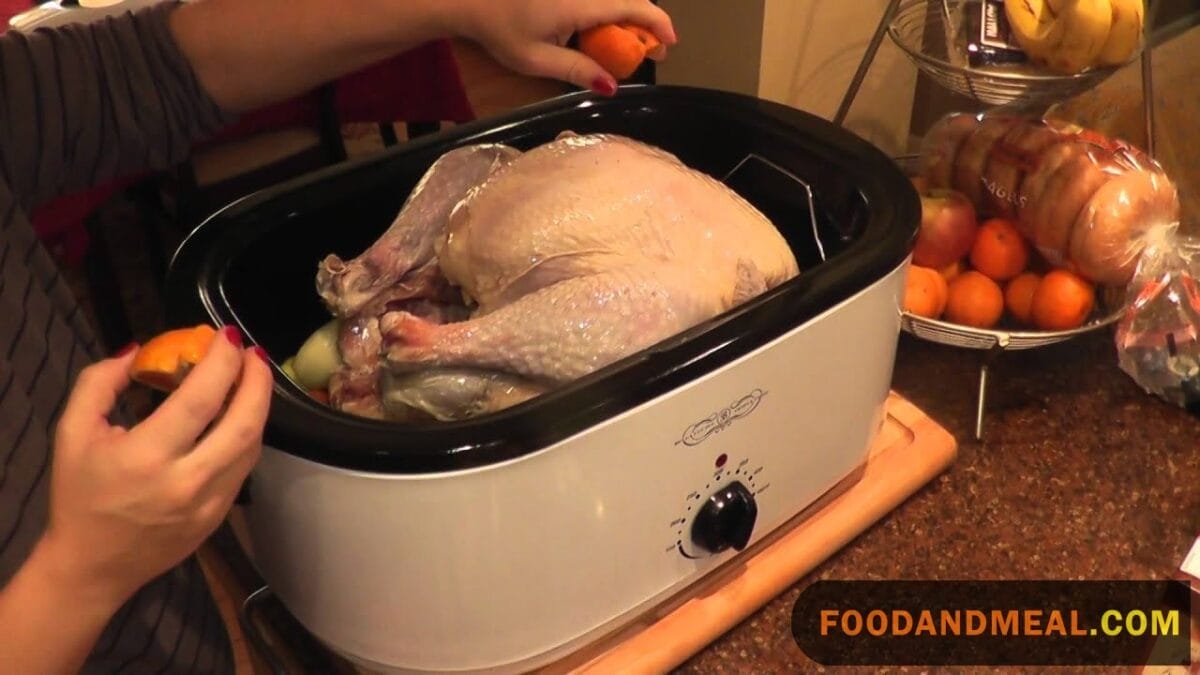Food and Meal find that roasting pans aren’t limited to Thanksgiving; they bring versatility to any kitchen. We have experienced their usefulness in roasting meats such as turkey, chicken, game hens, pork, and beef. The expansive surface area allows us to roast vegetable side dishes alongside our main courses. Moreover, roasting pans serve as oversized baking dishes for casseroles or cakes.
However, if we anticipate using a roasting pan only on Thanksgiving, a more practical approach might be crafting our DIY roasting pan and rack. This way, we can avoid unnecessary cabinet space consumption. We can discover how to create our homemade roasting pan and rack duo using items we likely already have in our kitchen.

What Is a Roasting Pan and How Do They Work?
Before we embark on creating our own roasting pan, it’s crucial to grasp the mechanics behind them. Roasting pans typically feature high walls designed to trap heat, creating an ideal environment for cooking. Additionally, these high walls provide ample space to retain pan liquids, particularly useful for basting.
Most roasting pans come equipped with a roasting rack, serving the purpose of elevating the meat above the pan’s bottom. This elevation ensures even cooking and contributes to achieving that coveted crisp skin, as opposed to the potential sogginess that can result from direct contact with pan juices.
Above all, roasting pans are sizable—quite sizeable, in fact. These pans and racks must bear the weight of an entire turkey while still fitting within the constraints of a standard oven. Therefore, when considering the creation of our DIY roasting pan, it’s essential to ensure it is oven-safe, spacious enough for the intended roast, and yet compact enough to fit seamlessly into our oven.
Roasting Pan Substitutes
When it comes to roasting, having a dedicated roasting pan is ideal, but in many instances, you can make do with alternative kitchenware that you likely already have. The key is to consider the size of the roast you’re working with and choose a vessel that provides enough space and functionality.
Casserole Dish
If you find yourself without a roasting pan, a casserole dish can step in admirably, particularly for smaller roasts like chicken or game hens. A standard 9×13-inch casserole or baking dish can serve this purpose well. For larger roasts such as a full-sized turkey, opt for an oversized baking dish with relatively high sides to contain the juices effectively.
Cast Iron Skillet
Another versatile option is a cast iron skillet, which is perfect for smaller roasts. Its ability to seamlessly transition from stovetop to oven makes it a valuable tool in the kitchen. The thick walls of a cast iron skillet facilitate even heat distribution during the roasting process.

Rimmed Baking Sheet
Surprisingly, a rimmed baking sheet can pull double duty as a makeshift roasting pan with a touch of ingenuity. The key here is to ensure the baking sheet has raised edges to prevent pan liquids from overflowing. Consider placing a sheet of aluminum foil underneath the baking sheet to catch any potential spills. For improved air circulation and even heating, try using a wire cooling rack (details on DIY roasting racks below) inside the baking sheet.
Foil Roasting Pan
For those occasions when you only roast infrequently and investing in a dedicated pan seems impractical, disposable foil roasting pans offer a cost-effective solution. While these pans may lack the sturdiness of more permanent options, their high sides and ample surface area make them suitable for roasting larger items, such as a turkey.
In essence, while a roasting pan is undoubtedly a convenient tool, improvisation with everyday kitchen items is not only possible but often quite effective. Consider the specifics of your roasting needs and utilize what you have at hand for a successful and flavorful cooking experience.
Roasting Rack Substitutes
When it comes to the art of roasting, a well-equipped kitchen often boasts a roasting pan with a dedicated rack to elevate the roast, ensuring optimal heat circulation. However, situations may arise where this essential tool is absent, prompting the need for inventive alternatives. Fear not, for we delve into creative solutions to lift your roast to culinary excellence without the traditional roasting rack.
Vegetables as a Natural Elevator
Harness the versatility of vegetables by creating a robust bed for your roast. Carrots, potatoes, celery, and onions, when strategically arranged at the pan’s base, not only lift the roast but also contribute nuanced flavors to the cooking process. This ingenious method not only solves the rack dilemma but adds a delightful twist to your culinary creation.
Aluminum Foil Innovation
Transform your kitchen into a workshop with a simple yet effective DIY roasting rack made from aluminum foil. Roll three to five pieces of foil into sturdy cylinders and place them across the pan’s bottom, emulating the structure of a conventional roasting rack. This impromptu setup ensures your turkey or roast is elevated, preventing it from soaking in pan juices and facilitating even cooking.

Wire Cooling Rack Brilliance
In the absence of a dedicated roasting rack, turn to a humble wire cooling rack as a worthy substitute. Select a cooling rack that fits snugly inside a standard baking dish, positioning it within your roasting pan. This impromptu flat roasting rack allows for proper air circulation around the roast, a key element for achieving uniform cooking and a delectable outcome.
Embrace these creative alternatives, turning potential kitchen challenges into opportunities for culinary ingenuity. Elevate your roasting game with resourceful solutions, ensuring that your roast emerges from the oven as a masterpiece of flavor and texture.
FAQs (Frequently Asked Questions)
Q: Can I roast meat without a roasting pan?
A: Yes, you can roast meat without a traditional roasting pan. Several alternative options can be used, depending on what you have available in your kitchen.
Q: What can I use instead of a roasting pan for a turkey or chicken?
A: Alternatives to a roasting pan for poultry include a baking sheet with a wire rack, a broiler pan, or a large oven-safe skillet.
Q: Can I use a glass baking dish for roasting?
A: Yes, a glass baking dish can be used for roasting. However, it’s advisable to lower the oven temperature by 25°F when using glass to prevent thermal shock.
Q: Are there any risks in using a different pan for roasting?
A: Using an alternative pan is generally safe, but it’s essential to consider the pan’s size, material, and ability to withstand high oven temperatures. Some materials may not be suitable for prolonged exposure to high heat.
Q: What can I use as a makeshift roasting rack?
A: If you don’t have a roasting rack, improvise with vegetables like carrots, celery, or onions to elevate the meat. Alternatively, crumpled aluminum foil can be used to create a makeshift rack.
Q: Can I use a disposable aluminum pan for roasting?
A: Yes, disposable aluminum pans can be used for roasting, especially for larger cuts of meat. However, be cautious about supporting the weight of a heavy turkey or roast.
Q: Can I roast vegetables without a roasting pan?
A: Absolutely. You can roast vegetables on a baking sheet, in a casserole dish, or even directly on an oven-safe skillet.
Q: How do I prevent drippings from causing a mess in the oven when using an alternative to a roasting pan?
A: To prevent a mess, place a layer of vegetables or a shallow pan under the meat to catch drippings. This not only helps with cleanup but can also enhance the flavor of the dish.
Q: Can I use a slow cooker or crockpot for roasting?
A: While slow cookers are excellent for braising and slow-cooking, they aren’t ideal for traditional roasting, as they don’t provide the same dry heat environment. Use alternative pans for better results.
Q: Can I use a cast-iron skillet for roasting?
A: Yes, a cast-iron skillet can be used for roasting, especially for smaller cuts of meat. Ensure it’s adequately seasoned to prevent sticking.
Q: Are there specific considerations when using alternative pans for roasting?
A: Yes, consider the size of the pan, its material, and its ability to handle high oven temperatures. Adjust cooking times as needed, and monitor the dish to prevent burning.
Q: Can I use a roasting bag without a roasting pan?
A: Yes, you can use a roasting bag placed on a baking sheet or in an alternative oven-safe dish. Follow the instructions on the roasting bag for best results.
Remember to adjust cooking times and monitor the cooking process when using alternative pans for roasting. The goal is to create a stable and safe cooking environment while achieving delicious results.
At Food and Meal, w
‘ve unlocked the potential of roasting pans beyond Thanksgiving, proving their versatility in everyday kitchens. Recognizing the occasional need for a roasting pan, especially during holidays, we’ve explored crafting a DIY version to save on storage space.
Understanding the basics of roasting pans—high walls, roasting racks, and appropriate sizing—is essential for successful roasting. We’ve identified practical substitutes like casserole dishes, cast iron skillets, rimmed baking sheets, and disposable foil pans to cater to various roasting needs.
For roasting rack alternatives, we’ve highlighted creative options, including using vegetables, crafting DIY racks with aluminum foil, or employing wire cooling racks. These inventive solutions showcase the kitchen’s resourcefulness.
In essence, whether equipped with a dedicated roasting pan or not, each roast can be a culinary masterpiece with a touch of creativity.
I'm Kelly Atkinson, with a passion for dissecting the world of home goods. My reviews stem from thorough testing and a love for sharing detailed insights. Each piece I write offers a glimpse into my explorative journey, aiming to guide readers to informed choices with authenticity and precision, making every review a blend of exploration and expertise.
